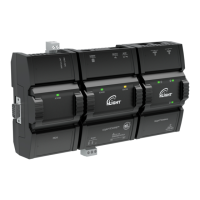CIDR Addressing
Another way to express the subnetwork mask is through CIDR addressing (Classless Inter-Domain Routing) which is writ-
ten as a slash and a number which represents the number of true bits set in the subnetwork mask. For example, the sub-
network mask 255.128.0.0 is 11111111 10000000 00000000 00000000 in binary or /9.
An IP address can be expressed with its CIDR subnetwork mask in the form of 192.168.0.0/24 for example.
Private IPv4 Address Ranges
Each IP address class has a private address range. Private IPv4 addresses cannot be routed over the Internet.
nLight ECLYPSE IP controllers will normally be assigned to a private IP address and are connected to the LAN ports of a
router, thereby keeping them behind a firewall from the internet while allowing them to freely communicate to each other
and to other trusted devices.
The following IPv4 address ranges are reserved for private networks.
Network Class IP Address Range Number of Addresses Largest CIDR Block (subnetwork mask)
A 10.0.0.0 - 10.255.255.255 16,777,216 10.0.0.0/8 (255.0.0.0)
B 172.16.0.0 - 172.31.255.255 1,048,576 172.16.0.0/12 (255.240.0.0)
C 192.168.0.0 - 192.168.255.255 65,536 192.168.0.0/16 (255.255.0.0)
Reserved Host Addresses
The first and the last IP addresses are reserved for special use on all subnetwork IP address ranges:
The first IP Address is the Network ID. Networks with different network IDs are considered to be distinct. By default, no di-
rect communication can take place between two networks that have different Network IDs. This prevents computers on
one network from being accessed by computers on another network. When one department or organization is on one net-
work, it is segregated from computers on other networks.
Last IP Address is the Broadcast Address: this is used for a specific type of network traffic that is destined to every host in
the subnetwork range of IP addresses. For example, the device’s DHCP client uses the broadcast address to find the net-
work’s DHCP server.
For Example, with a typical class C private network:
Subnetwork Mask = 255.255.255.0
Network ID = 192.168.1.0
Gateway = 192.168.1.1
Broadcast Address = 192.168.1.255
Usable IP Addresses = 192.168.1.2 - 192.168.1.254
Default Gateway
Two hosts on the same subnetwork can directly communicate with each other. When a host wants to communicate to an
IP address that is not in the subnetwork address range, the host sends the packet to the default gateway. The default gate-
way is usually the router’s IP address and is usually set in the routers administration interface. For more information about
IP routing, see About Routers, Switches, and Hubs.
Certain ECLYPSE controller services use the default gateway. See ECLYPSE Services that Require Internet Connectivity.
Domain Name System (DNS)
When you want to connect to another computer or service on the Internet (to a Website for example), rarely would you
want to use the IP address to make the connection as it would be a pain to remember the numeric IP address for each and
every site you want to visit. The Domain Name System (DNS) was created to allow internet users to take advantage of a
meaningful Uniform Resource Locator (URL) such as https://www.acuitybrands.com/
to connect to an IP address without
having to know the server’s or computer’s numerical IP address. The DNS does this by looking up the URL and providing
the numeric IP address to the requesting computer. Should the IP address of a computer/server be changed, the DNS
server can be updated with its new IP address, thereby ensuring that other networked computers can still find this com-
puter/server through its URL.
IPv4 Communication Fundamentals
15
nLight ECLYPSE

